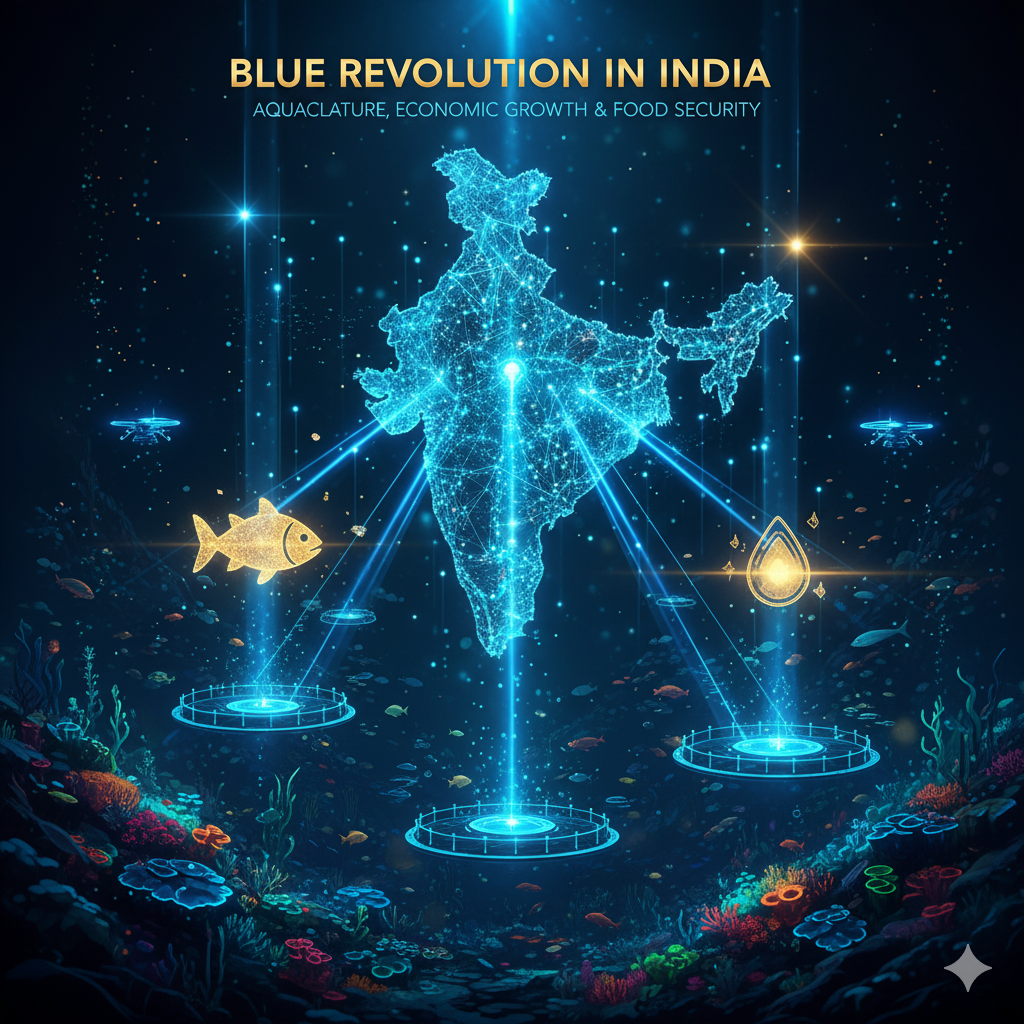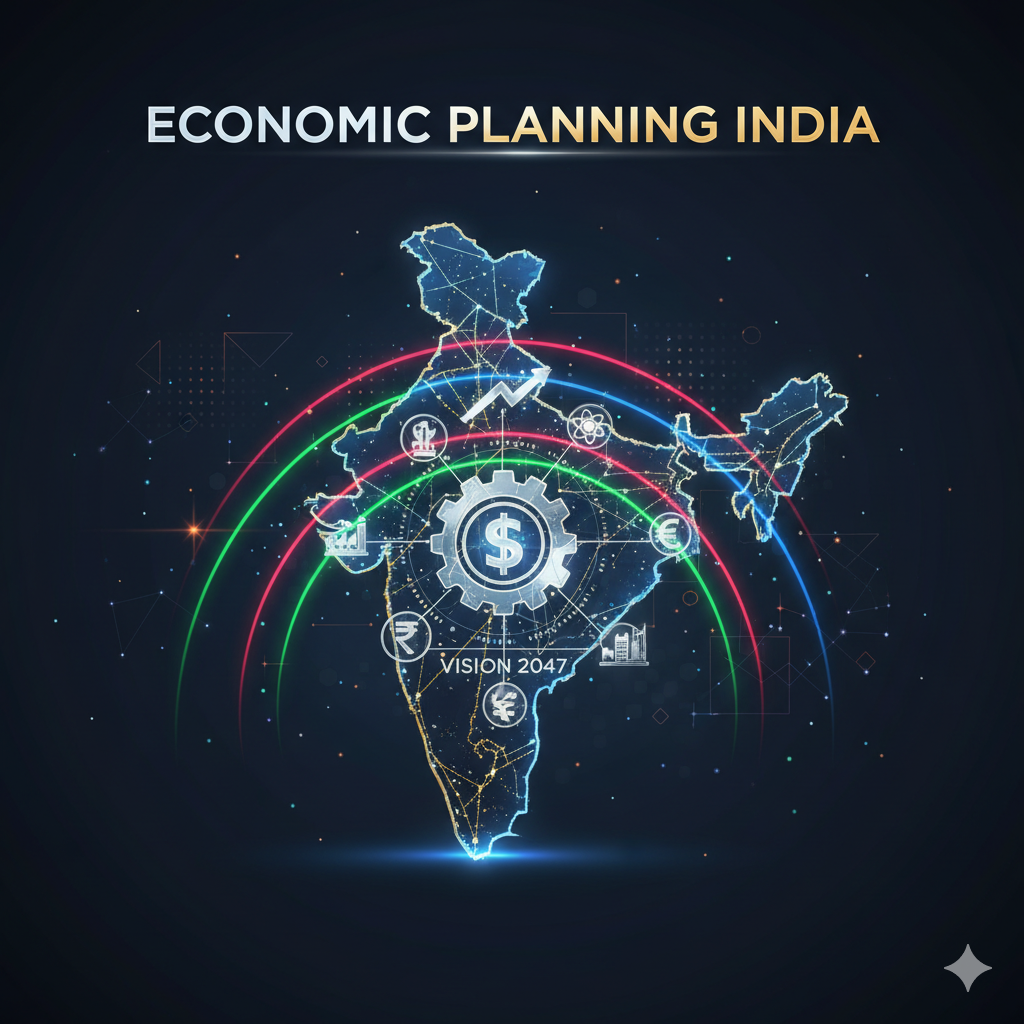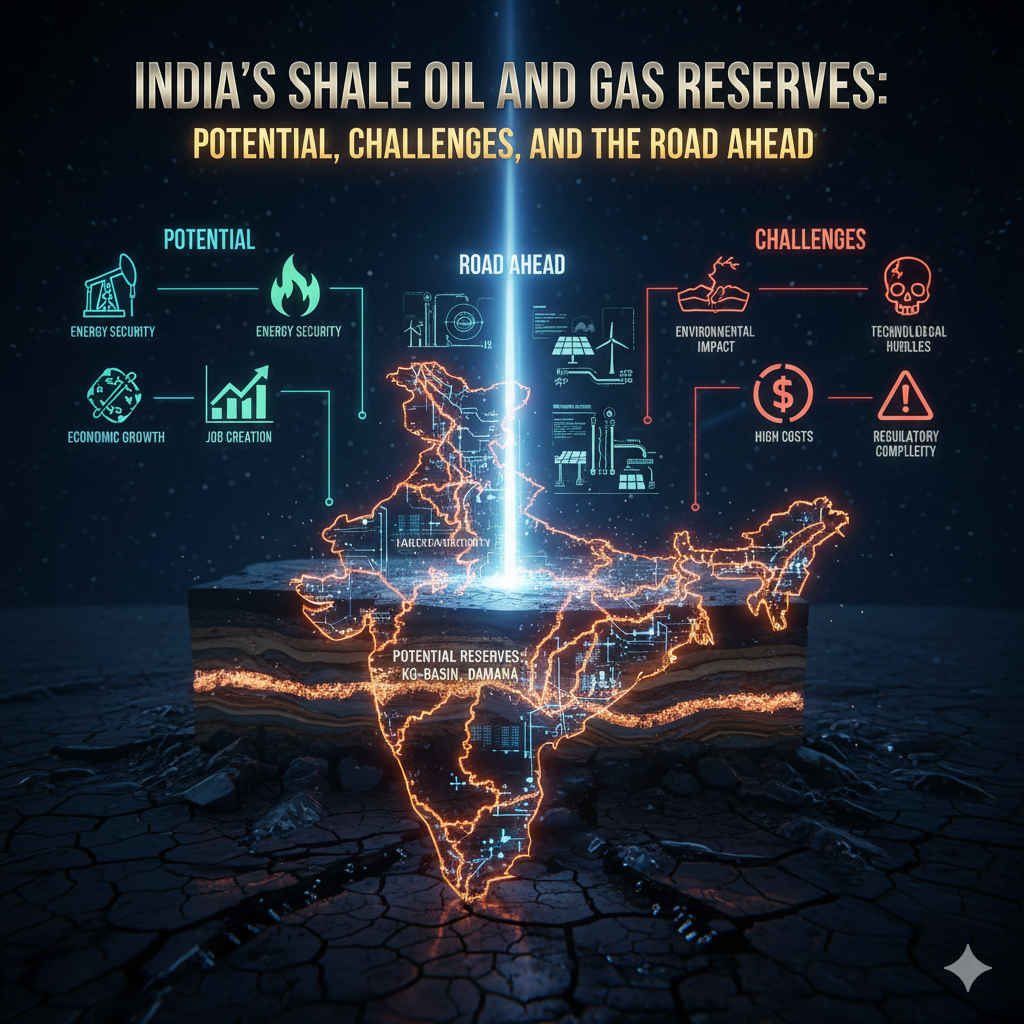Introduction
The term “Blue Revolution” refers to the rapid and sustainable development of the aquaculture and fisheries sector to increase fish production, ensure food security, and improve livelihoods. Coined in the 1970s, the concept of the Blue Revolution parallels the Green Revolution in agriculture, emphasizing productivity enhancement through modern technology, scientific management, and infrastructure development.
India, with a coastline of over 7,500 km, vast inland water resources, and a strong tradition of fish consumption, is uniquely positioned to harness the benefits of the Blue Revolution. The sector contributes significantly to the economy, employment, and nutritional security. However, despite considerable achievements, pisciculture in India faces multiple challenges that must be addressed through comprehensive strategies for sustainable development.
1. Definition and Significance of the Blue Revolution
1.1 Definition
The Blue Revolution is defined as:
“A program aimed at the rapid increase in fish production and productivity through scientific aquaculture, modern fishing techniques, and management of aquatic resources, ensuring economic, nutritional, and employment benefits.”
It encompasses:
- Inland fisheries: Rivers, lakes, reservoirs, ponds, and tanks.
- Marine fisheries: Coastal and deep-sea fishing.
- Aquaculture/Pisciculture: Scientific breeding, rearing, and harvesting of fish.
1.2 Significance
- Food and Nutritional Security:
Fish is rich in protein, omega-3 fatty acids, and micronutrients, addressing malnutrition in both rural and urban populations. - Employment Generation:
The fisheries sector provides livelihood for over 1.5 crore people in India, particularly in rural coastal areas. - Economic Contribution:
Fish production contributes significantly to the GDP through exports, domestic consumption, and allied industries. - Export Potential:
India is among the top producers and exporters of seafood, with shrimp, prawns, and fish contributing to foreign exchange earnings. - Rural Development:
Development of aquaculture in rural and semi-urban areas ensures sustainable livelihoods and reduces migration pressures.
2. Status of Pisciculture in India
India ranks second in global fish production, after China, with both marine and inland fisheries contributing substantially. Key highlights:
- Marine Fisheries:
- Annual contribution: ~3.7 million tonnes.
- Coastal states like Andhra Pradesh, Tamil Nadu, Kerala, Gujarat, and Maharashtra dominate production.
- Inland Fisheries:
- Rivers, lakes, ponds, and reservoirs contribute over 7 million tonnes annually.
- States like West Bengal, Bihar, Assam, Odisha, and Uttar Pradesh are major inland fish producers.
- Aquaculture:
- India has become a global leader in shrimp and freshwater fish farming.
- Pond-based, cage-based, and tank-based systems are widely used.
Despite this, India’s fish production potential remains underutilized, with challenges in technology adoption, resource management, and infrastructure.
3. Problems in Pisciculture Development in India
The growth of the Blue Revolution in India is constrained by multiple factors. These can be categorized into biological, infrastructural, socio-economic, and policy-related problems.
3.1 Biological and Environmental Problems
- Overfishing:
- Unregulated fishing depletes fish stocks in rivers, reservoirs, and coastal waters.
- Use of destructive methods like trawl nets and dynamite fishing destroys juvenile fish and breeding grounds.
- Disease Outbreaks:
- Intensive aquaculture often leads to viral, bacterial, and parasitic infections, affecting productivity.
- Examples: White Spot Syndrome in shrimp and Epizootic Ulcerative Syndrome in freshwater fish.
- Water Pollution:
- Industrial effluents, untreated sewage, and agrochemicals contaminate freshwater and coastal habitats.
- Polluted water reduces survival rates and quality of cultured fish.
- Climate Change Impacts:
- Rising sea temperatures, cyclones, and irregular monsoons affect breeding, migration, and pond water quality.
- Ocean acidification threatens shellfish and shrimp production.
- Limited Indigenous Breeding Stock:
- Many high-yield varieties are exotic and require controlled conditions, making rural adoption difficult.
3.2 Infrastructural Problems
- Lack of Modern Hatcheries:
- Inadequate hatchery infrastructure limits the availability of quality fish seeds.
- Many areas rely on traditional breeding methods with low survival rates.
- Poor Storage and Cold Chain Facilities:
- Fish is highly perishable; lack of refrigerated transport and storage leads to post-harvest losses of 20–30%.
- Fish is highly perishable; lack of refrigerated transport and storage leads to post-harvest losses of 20–30%.
- Insufficient Marketing Infrastructure:
- Inadequate fish markets and supply chains prevent efficient price realization.
- Middlemen dominate, reducing profit margins for farmers.
- Limited Access to Quality Feed and Inputs:
- Inconsistent availability of formulated feed, aeration systems, and water quality management tools restricts productivity.
3.3 Socio-Economic Problems
- Fragmented Land Holdings:
- Small pond sizes limit economies of scale and adoption of modern technology.
- Small pond sizes limit economies of scale and adoption of modern technology.
- Low Awareness and Skill Levels:
- Farmers lack training in modern aquaculture practices, disease management, and sustainable methods.
- Farmers lack training in modern aquaculture practices, disease management, and sustainable methods.
- Financial Constraints:
- High investment costs for ponds, hatcheries, feed, and equipment discourage small-scale farmers.
- High investment costs for ponds, hatcheries, feed, and equipment discourage small-scale farmers.
- Gender Inequality:
- Women often play a key role in fish processing and marketing but face limited access to credit, training, and decision-making.
3.4 Policy and Institutional Problems
- Weak Implementation of Schemes:
- Government programs sometimes fail due to bureaucratic delays and poor monitoring.
- Government programs sometimes fail due to bureaucratic delays and poor monitoring.
- Limited Research and Extension Services:
- Inadequate transfer of technology from research institutions to fish farmers reduces productivity gains.
- Inadequate transfer of technology from research institutions to fish farmers reduces productivity gains.
- Resource Conflicts:
- Conflicts over water use between agriculture, industry, and aquaculture can limit pond availability.
- Conflicts over water use between agriculture, industry, and aquaculture can limit pond availability.
- Environmental Regulations:
- Strict environmental laws, though necessary, sometimes create hurdles in pond construction, effluent management, and coastal aquaculture expansion.
4. Strategies for Pisciculture Development in India
To address these challenges, India requires multi-dimensional strategies involving policy reforms, technological innovation, infrastructure development, and community participation.
4.1 Policy and Institutional Strategies
- Implementation of National Fisheries Policy (NFP) 2020:
- Emphasizes sustainable fisheries, aquaculture promotion, and value addition.
- Supports small-scale fishers and women’s participation.
- Subsidies and Financial Assistance:
- Provide low-interest loans and grants for pond construction, hatcheries, and aquaculture inputs.
- Provide low-interest loans and grants for pond construction, hatcheries, and aquaculture inputs.
- Strengthening Research Institutions:
- ICAR-Central Institute of Fisheries Education, CMFRI, and state universities can focus on disease-resistant fish breeds, climate-resilient aquaculture, and feed technology.
- ICAR-Central Institute of Fisheries Education, CMFRI, and state universities can focus on disease-resistant fish breeds, climate-resilient aquaculture, and feed technology.
- Improved Regulatory Framework:
- Balanced policies to protect coastal ecosystems while promoting shrimp and marine aquaculture.
4.2 Technological Strategies
- Modern Hatchery Techniques:
- Establishment of high-tech hatcheries for carp, catla, rohu, shrimp, and ornamental fish.
- Establishment of high-tech hatcheries for carp, catla, rohu, shrimp, and ornamental fish.
- Integrated Fish Farming:
- Combining fish farming with poultry, dairy, and agriculture enhances nutrient recycling, reduces costs, and increases productivity.
- Combining fish farming with poultry, dairy, and agriculture enhances nutrient recycling, reduces costs, and increases productivity.
- Use of Scientific Feed and Fertilizers:
- Adoption of nutritionally balanced commercial feed reduces dependency on natural food and improves growth rates.
- Adoption of nutritionally balanced commercial feed reduces dependency on natural food and improves growth rates.
- Water Quality Management:
- Aeration devices, biofilters, and periodic water testing maintain optimal oxygen and pH levels.
- Aeration devices, biofilters, and periodic water testing maintain optimal oxygen and pH levels.
- ICT and Digital Tools:
- Mobile apps for market prices, disease alerts, and weather updates help farmers make informed decisions.
4.3 Infrastructure and Market Development
- Cold Chain and Storage Facilities:
- Refrigerated transport, ice plants, and cold storage reduce post-harvest losses.
- Refrigerated transport, ice plants, and cold storage reduce post-harvest losses.
- Modern Fish Markets:
- Establish fish marts and direct marketing platforms to ensure fair prices and reduce middlemen.
- Establish fish marts and direct marketing platforms to ensure fair prices and reduce middlemen.
- Transport and Export Facilities:
- Expand coastal shipping, inland waterways, and air transport for timely delivery of fresh fish.
4.4 Community-Based and Social Strategies
- Training and Capacity Building:
- Conduct workshops on modern aquaculture practices, disease management, and sustainable fish farming.
- Conduct workshops on modern aquaculture practices, disease management, and sustainable fish farming.
- Women’s Empowerment in Pisciculture:
- Support women-led fish processing units, cooperative societies, and marketing initiatives.
- Support women-led fish processing units, cooperative societies, and marketing initiatives.
- Formation of Fishermen Cooperatives:
- Collective management of resources ensures equitable distribution, technical support, and shared infrastructure.
- Collective management of resources ensures equitable distribution, technical support, and shared infrastructure.
- Awareness Programs:
- Promote sustainable fishing methods and environmental conservation among coastal communities.
4.5 Environmental Sustainability Measures
- Pollution Control:
- Prevent industrial effluent and sewage discharge into rivers and coastal areas.
- Prevent industrial effluent and sewage discharge into rivers and coastal areas.
- Mangrove and Wetland Conservation:
- Protect coastal habitats that act as nurseries for fish and shellfish.
- Protect coastal habitats that act as nurseries for fish and shellfish.
- Sustainable Stocking Practices:
- Avoid overstocking ponds to reduce disease risks and environmental stress.
- Avoid overstocking ponds to reduce disease risks and environmental stress.
- Climate-Resilient Aquaculture:
- Use drought- and flood-resistant fish varieties and construct ponds with water conservation measures.
5. Case Studies of Successful Pisciculture Initiatives
5.1 West Bengal: Integrated Fish Farming
- Combines fish culture with rice paddies.
- Enhances nutrient recycling, increases productivity, and reduces pesticide usage.
5.2 Andhra Pradesh: Shrimp Aquaculture
- Development of brackish water shrimp farming with modern hatcheries.
- Provides high export revenue and employment for coastal communities.
5.3 Kerala: Cooperative Fish Marketing
- Fishermen cooperatives ensure better pricing, reduce exploitation by middlemen, and promote sustainable fishing practices.
6. Future Prospects of Blue Revolution in India
- Export Potential Expansion:
- Increased demand for seafood globally presents opportunities for shrimp, tuna, and ornamental fish exports.
- Increased demand for seafood globally presents opportunities for shrimp, tuna, and ornamental fish exports.
- Technological Innovation:
- AI, IoT, and automated feeding systems can improve efficiency and sustainability.
- AI, IoT, and automated feeding systems can improve efficiency and sustainability.
- Climate-Adaptive Practices:
- Adoption of climate-resilient aquaculture practices ensures long-term productivity.
- Adoption of climate-resilient aquaculture practices ensures long-term productivity.
- Integrated Policy Support:
- Collaboration between central and state governments, research institutions, and the private sector can make India a global leader in sustainable pisciculture.
Conclusion
The Blue Revolution represents a transformative opportunity for India to enhance fish production, ensure food security, generate employment, and boost exports. While the sector faces challenges such as overfishing, pollution, disease outbreaks, and infrastructural deficiencies, a combination of technological innovation, policy support, community participation, and environmental sustainability can address these problems.
By promoting integrated fish farming, modern hatcheries, cold chains, market reforms, and climate-resilient practices, India can achieve sustainable growth in pisciculture and secure the livelihoods of millions of people dependent on fisheries. The success of the Blue Revolution is not only vital for economic development but also for improving nutrition, rural prosperity, and ecological balance.
Key Summary Points
The Blue Revolution has potential to enhance food security, employment, export revenue, and rural development.
Blue Revolution focuses on scientific aquaculture and sustainable fisheries development.
India has vast potential in marine and inland fisheries but faces problems in overfishing, disease, pollution, infrastructure, and policy gaps.
Strategies include modern hatcheries, integrated fish farming, cold chain development, ICT use, policy support, and community-based management.
Environmental sustainability, mangrove protection, and climate-resilient practices are critical for long-term success.
Case studies from West Bengal, Andhra Pradesh, and Kerala demonstrate practical success.




